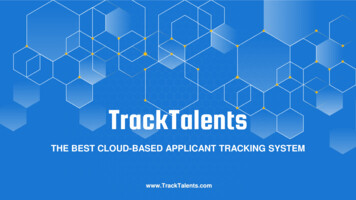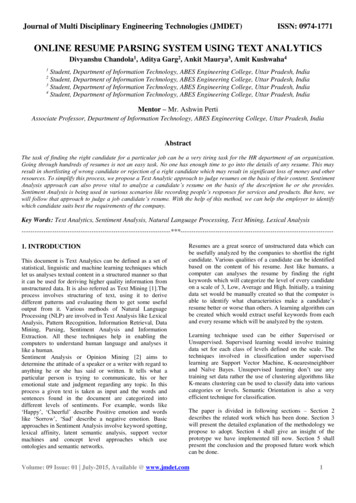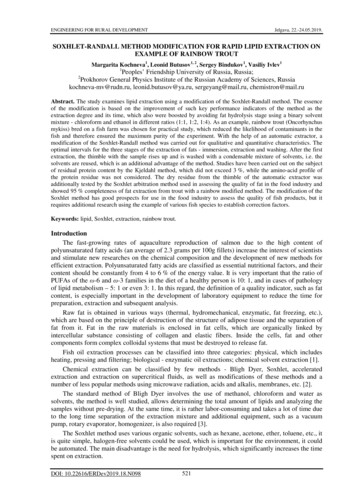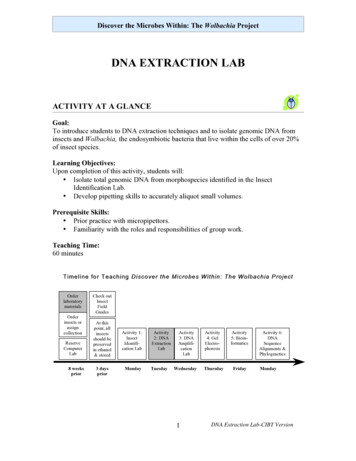
Transcription
Journal of Xi'an University of Architecture & TechnologyISSN No : 1006-7930AN EFFECTIVE RESUME DATA EXTRACTION WITHADVANCE ALGORITHMSA SAI SARATH, DR. MOORAMREDDY SREEDEVI,MCA STUDENT, DEPT. OF COMPUTER SCIENCE ,S.V.UNIVERSITY, TIRUPATISENIOR ASSISTANT PROFESSOR, DEPT. OF COMPUTER SCIENCE,S.V.UNIVERSITY, TIRUPATIAbstractIn recent years we have seen the fast advancement of deep neural networks anddispersed portrayals in natural language processing. Be that as it may, the uses ofneural networks in resume parsing need orderly examination. It is difficult to channeleducational plans vitae from an uncountable pack of educational plans vitae reports. Itwill be exceptionally simple to channel if the data from all educational plans vitae in aplain arrangement in a solitary record. we can accomplish this even configurationthrough data mining methods. The separated data can be additionally sent out to exceedexpectations position. In this paper, the word records are perused from the client inputindexes and the data is separated from those reports utilizing data mining methods. Thedata which is removed from archives will be changed over to plain configuration tobreak down without any problem. The organized line classification by both line typeclassifier and line mark classifier successfully fragment a resume into predefined textsquares. Our proposed pipeline joints the text square division with the recognizableproof of resume realities in which different arrangement marking classifiers performnamed entity recognition inside named text squares. Near assessment of four successionnaming classifiers affirmed BLSTM-CNN's-CRF's predominance in named entityrecognition task. Further correlation among three pitched resume parsers additionallydecided the viability of our text square classification strategy.KEYWORDSResume Parsing, Word Embeddings, Named Entity Recognition, Text Classifier, NeuralNetworks.I.INTRODUCTIONThe Internet-based selecting stages assumea significant job in the enlistment channel[1] with the fast development of theInternet. These days, pretty much everyorganization or division posts its activityprerequisites on different internet enlistingstages. There are more than one thousandoccupation necessities transferred everyVolume XII, Issue V, 2020momentinMonster.com(http://www.monster.coma Online enrollingis hugely helpful for sparing time for thetwo businesses and representatives. Itpermits the activity searchers to presenttheir resumes to numerous representativessimultaneously without going to theworkplace and it additionally sparesrepresentatives time to sort out anPage No: 2172
Journal of Xi'an University of Architecture & TechnologyOccupation reasonable. In the interim, thereare additionally numerous entries goingabout as outsider assistance between worksearchers and friends HR, with the goal thatloads of resumes are gathered by theseentryways. For example, Linkedln.com(http://www.linkedin.com) has gathered inexcess of 300 million individual resumestransferred by clients. Due to the expandingmeasure of data, how to adequately breakdown each resume is an extreme issue,which pulled in the consideration ofscientists. In reality, work searchers as arule utilize assorted resume text designs anddifferenttypesettingtoacquireconsideration. Loads of resumes are notcomposed by a standard arrangement or aparticular format record. This marvelimplies that the structure of resume data hasa lot of vulnerability. It diminishes theachievement pace of suggesting initiateswho meet a large portion of the business'necessities and occupy a lot of time of HRto do work coordinating. To improve theeffectiveness of occupation coordinating,investigating a powerful strategy tocoordinate employments and competitors issignificant and fundamental. Additionally,resume mining is useful to do clientdisplaying of the enrollment stage [2]. Asper its utilization situations, individualresume data has a few properties as follows.To begin with, work searchers composetheir resumes with fluctuating typesetting,however a large portion of the resumesinclude general text squares, for example,individual data, contacts, instructions, andwork encounters. Second, individualResumes share the report level progressivecontextual structure [3], which is sharedamong various things in the comparing textsquare of each resume. The fundamentalexplanation behind this marvel is that thingsin a text square having comparable variousleveled data can make the entire resumeincreasingly agreeable for peruses. Mostimportantly, a resume can be portioned intoa few text squares; at that point realities canVolume XII, Issue V, 2020ISSN No : 1006-7930be recognized dependent on the particularvarious leveled contextual data. Lately,numerous e-enrollment instruments areproduced for resume data extraction. Albeitfundamental speculations and processingstrategies for web data extraction exist, alarge portion of the apparatuses for eenlistment despite everything experiencethe ill effects of text processing andcompetitor coordinating with the activityprerequisites [4]. There are three primaryextraction ways to deal with manageresumes in past research, includingkeyword search based technique, rule-basedstrategy, and semantic-based strategy. Sincethe subtleties of the resume are difficult toseparate, it is an elective method toaccomplish the objective of occupationcoordinating with the keywords searchapproach [3, 5]. Enlivened by the method ofextricating the news website page [6-10], afew principle based extraction approaches[11-13] treat the resume text as a page andafterward separate point by point realitiesdependent on the DOM tree structure. Forthe last sort of strategy, analysts treat theresume separating task as a semantic-basedentity extraction issue. A few analystsutilize the grouping naming procedure [1417] or text classification techniques [18] toforesee the labels for portions of each line.Notwithstanding, a large portion of thesetechniques emphatically depend on variousleveled structure data in resume text and alot of marked data. Actually, learning oftext extraction models frequently dependson data that are named/clarified by a humanmaster. Additionally, the more aptitude andtime the marking procedure requires, themore expensive it is to name the data.Likewise, there might be limitations onwhat number of data cases one master canpractically name. More insights regardingthese three sorts of strategies will bepresented in Section 2. This paper centerson the extraction calculation that isproposed for resume truth extraction. Ourcommitments are as per the following. (1)We propose a novel two-advance dataextraction calculation. (2) Another sentencePage No: 2173
Journal of Xi'an University of Architecture & Technologygrammar data, Writing Style, for each linein the resume is structured in this paper. Itis utilized to get semi structured data fordistinguishing the point by point verifiabledata. (3) We give an exact confirmation ofthe viability of the proposed extractioncalculation.II.RELATED WORKSThe resumes available from the Internet canbe ordered into two classes: the free plaintexts and organized increased texts. TheInformationextractionalgorithmsprincipally intended for plain texts will ingeneral maintain a strategic distance fromany speculation over organized increasedtexts. It is on the grounds that thesealgorithms depend on vocabularies andsentence structures and don't utilize theextra linguistic components, for example,the HTML labels. Then again, theInformation extraction algorithms intendedfor organized increased texts are ineffectualover plain texts. It is on the grounds thatthey can't conquer the data meagercondition in view of the high adaptability ofnatural language.2.1 Resume Parsing Based On PlainTextMoving toward the resume data as a variousleveled structure as opposed to a levelstructure, Yu et al. introduced a semanticbased fell half breed model for resumeentity extraction [3]. In the primary pass,the Hidden Markov model (HMM)portioned a resume into back to backsquares of differing data types [3]. At thatpoint dependent on the classification, thesubsequent pass utilized HMM to extricatethe definite instructive data and SVM to getnitty gritty individual data [3]. By regardingthe resume data as a level structure, Chen etal. proposed a two-advance resume dataextraction calculation [4]. One talecommitment was the presentation of alinguistic structure includes, the WritingStyle, to show each sentence of a resumeVolume XII, Issue V, 2020ISSN No : 1006-7930[4]. In the initial step, lines of crude textwere ordered into semi-organized textsquares [4]. In the subsequent advance, thecalculation used the gullible Bayesclassifier to recognize realities from the textsquares dependent on the Writing Style [4].Doing without the progression of sectioningthe resumes into text squares, Chen et al.later introduced an information extractionsystem for resumes parsing dependent ontext classifiers [5]. Chen et al. grouped thearrangement of every text line into threemarks: Simple, Key-Value, and Complex[5]. The subsequent semi-organized datawas then used to remove realities with textclassifiers [5]. Han et al. proposed aSupport Vector Machine based metadataextraction [6]. This strategy performed freeline classification followed by an iterativecontextual line classification to improve theclassification precision utilizing theneighbor lines' anticipated names [6]. Theorganized example of the data, the areaexplicit word grouping, and highlightstandardization improved the metadataextraction execution [6]. As a rule, theresumes additionally present themselves ineven structure. The perplexing andequivocal table components presenttroubles for conventional successionmarking methods. By utilizing ConditionalRandom Field as the classifier, Pinto et al.effectively grouped every constituent tableline with a predefined tag showing itscomparing capacity, i.e., table header,separator, and data push [7]. PROSPECT isan enrollment emotionally supportivenetwork that permits the screeners torapidly choose competitors dependent onindicated separating standards or blends ofnumerous questions [8]. PROSPECT'sresume parser is contained three sections:Table Analyzer (TA), Resume Segmenter(RS), and Concept Recognizer (CR) [8]. TAis liable for basically dismembering tablesinto classes and removing data from them[8]. RS fragments resume into predefined,homogeneous, continuous textual squares[8]. The divided textual areas are thenparsed by CRF-based extractors to inferPage No: 2174
Journal of Xi'an University of Architecture & Technologynamed elements [8]. AIDAS is a canny wayto deal with deciphers sensible recordstructures from PDF archives [9]. In viewof the shallow sentence structures, AIDASallocates a lot of capacities to every designobject. These capacities gradually pieceevery format object into littler articles bymeans of a base up design until each thingis commented on by an area philosophy [9].As far as keywords-based resume parsing,Maheshwari et al. manufactured a questionto improve the productivity of competitorpositioning by separating explicit expertisetypes and qualities [10]. The ability datawas utilized to separate the Skill TypeFeature Set (STFS) and Skill Value FeatureSet (SVFS) [10]. The Degree of Specialness(DS) can be determined on these twocapabilities to screen out the mostreasonable applicants.2.2. ResumeWebsitesParsingdependentthat point EXPERT recovers the qualifiedup-and-comers by mapping the activitynecessity metaphysics onto the applicantcosmology by means of comparabilityestimation[12]. Craven et al. introduced a standardbased versatile parser for web-related textdependent on Learning Pattern byLanguage Processing (LP) 2 calculation[13, 14]. This calculation learns runs bysumming up over a lot of examples in apreparation corpus set apart by XML labels[13, 14]. This calculation performspreparing by initiating a lot of labelingrules, trailed by labeling imprecisionamendment [13, 14]. The shallow NLP isused to sum up rules past the level wordarrangements since it constrains the datascantiness and tackles the over fitting issue[13, 14].onSince most outsider enrollment gatewaysuse site pages to display the resumes, theanalysts additionally examine differentparsing methods for web-related resumes. Jiet al. applied a label tree calculation toextricate records and pattern from resumesite pages dependent on the DocumentObject Model (DOM) [11]. In DOM, theinner hubs speak to the characteristics,while the leaf hubs comprise of the point bypoint realities. This calculation parsesdiverse site pages into the label trees fromwhich the label tree formats can beproduced by means of a cost-based treecloseness metric [11]. The label tree layoutscan parse selective substance from eachresume [11]. The realities can be gottenfrom the elite substance by finding rehashedexamples or heuristic guidelines [11].Master is one of the current resumeproposal frameworks that influence thecosmology to display the profiles ofoccupation searchers [12]. This frameworkdevelops the cosmology records for thehighlights of gathered resumes andemployment postings, individually [12]. AtVolume XII, Issue V, 2020ISSN No : 1006-7930III. PROPOSAL METHODOLOGYResumeApproachInformationExtractionBy solidifying the ideas from text squareclassificationandresumerealitiesrecognizable proof, we present the entiremethodology for resume data extraction.Figure 3 outlines the pipeline for ourproposed resume parsing calculation.Assume we slither down a resume from theInternet; we utilize the pdf-miner and Docxdevices to change over it into the textdocument by evacuating all the formats. Weexecute data cleaning on the text resume bybringing together various accentuations,evacuating stop words, and low-recurrencewords. From that point forward, we addeach line of the text resume to a line list.We iteratively convert the lines from theline list into the word vectors. We tokenizeeach word from each line and guide it intothe word vector by looking into its jargonrecordinthepre-preparedwordembeddings. For line type and line nameclassification, the contribution of the linetype and line name classifiers don't requireany built highlights past the word vectors.Page No: 2175
Journal of Xi'an University of Architecture & TechnologyThe line type classifier will classify eachline into four nonexclusive formats. Theline mark classifier further refines theunpleasant classification by ordering eachline into six general data fields. Thisclassification course will create progressiveline groups with shared marks characteristicof the limits for text squares. Subsequently,we portion another resume into text hinderswith predefined marks. For resume realitiesrecognizable proof, we iteratively apply thesuccession marking classifiers to the wordISSN No : 1006-7930vectors of every text obstruct related to thetext highlights we configuration ahead oftime. The succession marking classifierswill distinguish any named substances theycan perceive. To coordinate the namedsubstances to the standard characteristicnames, the k-implies calculation is utilizedto do trait grouping by registering theTFIDF-based cosine likenesses between thenamed entity up-and-comersFigure 3. Pipeline for Proposed Resume Information Extraction AlgorithmIV.RESULTS ANALYSISMost neural networks-based arrangementnaming frameworks use different highlightsto enlarge instead of supplant the wordvectors. We figured out how to run theremoval study to affirm that the CNN layerof BLSTM-CNN's-CRF naturally fills in asthe text include extractor. The programmedextraction of text highlights reenacts theprocessing of developing different textincludes physically. We applied Bi-LSTMCRF exclusively on the word vectors anddetermined the F-1 measures forrecognizing different resume realities. Weadditionally expelled the CNN layer fromBLSTM-CNN's-CRF and let the shortenedclassifier play out the NER. Table 3 showsthe outcomes for the removal try. We findthat the succession naming execution of BiLSTM-CRF without text highlights wasVolume XII, Issue V, 2020equivalent to that of the shortened BLSTMCNN's-CRF. We pick a few fields to clarifyour perception since we have talked aboutthe vast majority of them in the past area.Regarding the telephone number, weplanned a text include, all lettersAre digits that can represent its noveltextual attributes? Thusly, after we expelledthis text include, the F-1 measures fortelephone number recognizable proof werealtogether diminished. At the point whenthe PC ability is thought of, the texthighlights start with an uppercase letter andblends in with letters and digits, add to itsrecognition. In any case, when these twotext highlights were evacuated, thearrangement naming execution of Bi-Page No: 2176
Journal of Xi'an University of Architecture & TechnologyLSTM-CRF was boundlessly corrupted. Asfar as email addresses, we planned the textinclude, regardless of whether has images,to catch its particular arrangement. At thepoint when we evacuated this text include,Bi-LSTM-CRF had diminished NERexecution. Given that the NER execution ofBi-LSTM-CRF was comparable to that ofISSN No : 1006-7930the shortened BLSTM-CNN's-CRF, weinfer that CNN is a compelling way to dealwith remove text highlights or characterlevel data of a word.Table 3. The F-1 measures for resume facts identification in an ablation studyBi-LSTM-CRFBLSTM-CNN's-CRFField - aduation DateMajorDegreeCompany NameJob TitleJob DescriptionWork PeriodProject TitleProjectDescriptionProject PeriodLanguageComputer .8780.8380.8890.839CONCLUSIONIn rundown, we efficiently considered theresume data extraction dependent on themost recent methods in NLP. Mostpervasive resume parsers utilize customaryarticulation or fluffy keyword coordinatingto section the resumes into back to back textsquares. In light of every text square,different AI classifiers like SVM andcredulous Baye s perform resume realitiesVolume XII, Issue V, 2020Recognizable proof. In our investigation,we proposed a novel start to finish pipelinefor resume data extraction dependent ondisseminated embeddings and neuralnetworks-based classifiers. This pipelineadministers the tedious procedure ofdeveloping different hand-made highlightsphysically. The second commitment wemade is another methodology for textsquaredivision.Thismethodologyconsolidates both position-wise line dataand coordinated implications inside everytext square. Contrasted with hand-madehighlights, the programmed includePage No: 2177
Journal of Xi'an University of Architecture & Technologyextraction by neural networks can all themore likely catch the unobtrusive semantichighlights for delimiting the text squares.Quantitative examination between fiveproposed text classifiers recommended thatAttention BLSTM was compelling in textsquare classification and vigorous over bothshort and long sentences. Near assessmentbetween four freely distributed resumeparsers affirmed the predominance of ourtext square classification calculation. Weaccept that the iterative contextual lineclassification can additionally improve theautonomous line classification performedby coordination between line type classifierand line mark classifier. For resumerealities recognizable proof, we quantitivelythought about four sorts of arrangementmarking classifiers. Exploratory datashowed that BLSTM-CNN's-CRF waspowerful in performing named entityrecognition task. In light of our proposedresume data extraction strategy, we built upan online resume parser. This frameworkruns well in genuine condition. Most neuralnetworks-basedarrangementmarkingclassifiers require extra built highlights toexpand their grouping naming executionaside from BLSTM-CNN's-CRF. Weplayed out the removal study to check thatthe CNN layer of BLSTM-CNN's-CRF waspowerful in separating text highlights.CNN's are helpful in catching themorphological data of words mimicking theway toward structuring different textincludes physically. Also, near assessmentof various word embeddings proposed thatthe word portrayals were basic for namedentity recognition task. For futureexamination, we hope to improve theelements of our online resume parser byconsolidating the cosmology idea. Throughbuilding the cosmology for everyindividual, we plan to build up an abilityproposal framework.REFERENCESVolume XII, Issue V, 2020ISSN No : 1006-7930[1]Peng Zhou, Wei Shi, Jun Tian,Zhenyu Qi, Bingchen Li, Hongwei Hao,and Bo Xu (2016)“Attention-based Bidirectional Long Shortterm Memory Networks for RelationClassification”, InProceedings of the 54th Annual Meetingof the Association for ComputationalLinguistics(ACL’16), Berlin, Germany, August 7-12,2016, pp 207-212.[2]Xuezhe Ma, & Eduard Hovy (2016)“End-to-End Sequence Labelling via BidirectionalLSTM-CNN's-CRF”,InProceedings of the 54th Annual Meeting oftheAssociationforComputationalLinguistics (ACL’16), Berlin, Germany,August 7-12, 2016, pp 1064-1074.[3]Kun Yu, Gang Guan, and MingZhou(2005)“ResumeInformationExtraction with Cascaded Hybrid Model”In Proceedings of the 43rd Annual Meetingof the Association for ComputationalLinguistics (ACL’05), Stroudsburg, PA,USA, June 2005, pp 499-506.[4]Jie Chen, Chunxia Zhang, andZhendong Niu (2018) “A Two-StepResume Information ExtractionAlgorithm” Mathematical Problems inEngineering pp1-8.[5]Jie Chen, Zhendong Niu, andHongping Fu (2015) “A Novel KnowledgeExtraction Framework for Resumes Basedon Text Classifier” In Dong X., Yu X., LiJ., Sun Y. (eds) Web-Age InformationManagement (WAIM 2015) Lecture Notesin Computer Science, Vol. 9098, Springer,Cham.[6]Hui Han, C. Lee Giles, ErenManavoglu, HongYuan Zha (2003)“Automatic Document Metadata Extractionusing Support Vector Machine” InProceedings of the 2003 Joint Conferenceon DigitalPage No: 2178
Journal of Xi'an University of Architecture & TechnologyLibraries, Houston, TX, USA, pp 37-48.[7]David Pinto, Andrew McCallum,Xing Wei, and W. Bruce Croft (2003)“Table Extraction Using ConditionalRandom Field” In Proceedings of the 26thannualinternationalACMSIGIRconference on Research and development ininformation retrieval, Toronto, Canada, pp235- 242.[8]Amit Singh, Catherine Rose,Karthik Visweswariah, Enara Vijil, andNandakishore Kambhatla(2010) “PROSPECT: A system forscreening candidates for recruitment” InProceedings of the 19th ACM internationalconference on Information and knowledgemanagement, (CIKM’10), Toronto,ON, Canada, October 2010, pp 659-668.[9]Anjo Anjewierden (2001) “AIDAS:Incremental Logical Structure Discovery inPDF Documents”In Proceedings of 6th InternationalConference on Document Analysis andRecognition(ICDAR’01) pp 374-378.[10] SumitMaheshwari,AbhishekSainani, and P. Krishna Reddy (2010) “AnApproach to Extract Special Skills toImprove the Performance of ResumeSelection” Databases in NetworkedInformation Systems, Vol. 5999 of LectureNotes in Computer Science, Springer,Berlin, Germany, 2010, pp 256-273.[11] Xiangwen Ji, Jianping Zeng,Shiyong Zhang, Chenrong Wu (2010) “Tagtree template for Web information andschema extraction” Expert Systems withApplications Vol. 37, No.12, pp 8492-8498.[12] V. Senthil Kumaran and A. Sankar(2013) “Towards an automated system forintelligent screening of candidates forVolume XII, Issue V, 2020ISSN No : 1006-7930recruitment using ontology mapping(EXPERT)” International Journal ofMetadata, Semantics and Ontologies, Vol.8, No. 1, pp 56-64.[13] Fabio Ciravegna (2001) “(LP)2, anAdaptive Algorithm for InformationExtraction from Web-related Texts” InProceedings of the IJCAI-2001 Workshopon Adaptive Text Extraction and Mining.Seattle, WA.[14] Fabio Ciravegna, and AlbertoLavelli(2004)“LearningPinocchio:adaptive information extraction for realworld applications” Journal of NaturalLanguage Engineering Vol. 10, No. 2,pp145- 165.[15] Yan Wentan, and Qiao Yupeng(2017) “Chinese resume informationextraction based on semi-structure text” In36th Chinese Control Conference (CCC),Dalian, China.[16] Zhang Chuang, Wu Ming, Li ChunGuang, Xiao Bo, and Lin Zhi-qing (2009)“Resume Parser:Semi-structuredChinesedocumentanalysis” In Proceedings of the 2009 WRIWorld Congress onComputer Science and InformationEngineering, Los Angeles, USA, Vol. 5 pp12-16.[17] Zhixiang Jiang, Chuang Zhang, BoXiao, and Zhiqing Lin (2009) “Researchand Implementation of Intelligent Chineseresume Parsing” In 2009 WRI InternationalConference on Communications andMobile Computing, Yunan, China, Vol. 3pp 588-593.[18] Duygu Çelik, Askýn Karakas,Gülsen Bal , Cem Gültunca , Atilla Elçi ,Basak Buluz, and MuratCan Alevli (2013) “Towards an InformationExtraction System based on Ontology toPage No: 2179
Journal of Xi'an University of Architecture & TechnologyMatch Resumes and Jobs” In Proceedingsof the 2013 IEEE 37th Annual ComputerSoftware andApplicationsConferenceJapan, pp 333-338.Workshops,[19] Tomas Mikolov, Kai Chen, GregCorrado, and Jeffrey Dean (2013) “EfficientEstimation of Word Representations inVector Space” Computer Science, arXivpreprint arxiv:1301.3781.[20] Jeffrey Pennington, Richard Socher,and Christopher D. Manning (2014)“GloVe: Global Vectors for WordRepresentation” In Empirical Methods inNatural Language Processing (EMNLP) ppISSN No : 1006-7930[22] Yoon Kim (2014) ation” In Proceedings of the 2014Conference on Empirical Methods inNatural Language Processing (EMNLP) pp1746-1751.[23] Siwei Lai, Liheng Xu, Kang Liu, JunZhao (2005) “Recurrent ConvolutionalNeural Networks for Text Classification” InProceedings of Conference of theAssociation for the Advancement ofArtificial Intelligence Vol. 333 pp 22672273.1532-1543.[21] Jacob Devlin, Ming-Wei Chang,Kenton Lee, and Kristina Toutanova (2019)“BERT: Pre- training of Deep BidirectionalTransformers for Language Understanding”arxiv:1810.04805.AUTHOR PROFILEA SAI SARATH eema University in theyear of 2014- 2017. swaraUniversity.Thupati in the year of 20172020. Research interest in thefield of Computer Science intheareaofACOMPREHENSIVE REVIEWONPHONEMECLASSIFICATION IN MLMODELS.Volume XII, Issue V, 2020Dr. Mooramreddy Sreedevi,hasworking as a SeniorAssistant Professor in theDept. of Computer Science,S.V.University, Tirupati since2007. She obtained her Ph.D.ComputerSciencefromS.V.University, Tirupati. Sheacted as a Deputy Warden forwomen for 4 years and alsoacted as a Lady Representativefor 2years in SVU TeachersAssociation,S.V.University,Tirupati. She published 56research papers in UGCreputed journals, Participatedin30InternationalConferences and 50 Nationalconferences. She acted as aResource person for differentuniversities.Hercurrentresearch focuses in the areasof Network Security, DataMining, Cloud Computing andBig data analytics.Page No: 2180
Resume Parsing dependent on Websites Since most outsider enrollment gateways use site pages to display the resumes, the analysts additionally examine different parsing methods for web-related resumes. Ji et al. applied a label tree calculation to extricate records and pattern from resume .











